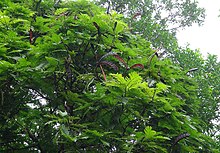| Pentaclethra | |
|---|---|

| |
| Pentaclethra macroloba tree in Costa Rica | |
| Scientific classification | |
| Kingdom: | Plantae |
| Clade: | Tracheophytes |
| Clade: | Angiosperms |
| Clade: | Eudicots |
| Clade: | Rosids |
| Order: | Fabales |
| Family: | Fabaceae |
| Subfamily: | Caesalpinioideae |
| Clade: | Mimosoid clade |
| Genus: | Pentaclethra Benth. |
| Species | |
|
Pentaclethra eetveldeana | |
Pentaclethra is a small genus of trees from the tropics. They are flowering plants in the family Fabaceae. They belong to the mimosoid clade of the subfamily Caesalpinioideae.
The name Pentaclethra is derived from Ancient Greek, penta meaning 'five', and cleithro meaning 'bolt', which alludes to the five imbricate sepals and five petals joined at the base, characteristic of this genus.
Species
Pentaclethra is a small genus with three species. It is considered basal to the mimosoid clade. One species, P. macroloba, occurs in the American tropics. This is the dominant tree in certain seasonal swamp forests in coastal areas of Atlantic Panama. The other two species occur in Africa.
Pentaclethra, popularly known as ugba (raw oil bean seeds) in Africa, has great nutritional value. Proximate analysis of raw oil bean seed reveals that it is composed of proteins (36–42%), lipids (43–47%) and carbohydrates (4–17%) The high content of the essential amino acids makes the seed a potential source of protein. Glutamic acid appears to be the largest amino acid contained in the seed and its fermented product. This could explain why pentaclethra (ugba) is often used as a flavoring agent for soups in southeastern Nigeria.
- Pentaclethra eetveldeana De Wild. & T.Durand
- Pentaclethra macroloba (Willd.) Kuntze
- Pentaclethra macrophylla Benth.
References
- The Legume Phylogeny Working Group (LPWG). (2017). "A new subfamily classification of the Leguminosae based on a taxonomically comprehensive phylogeny". Taxon. 66 (1): 44–77. doi:10.12705/661.3. hdl:10568/90658.
- ^ de Barros, Thais C.; Pedersoli, Giseli D.; Paulino, Juliana V.; Teixeira, Simone P. (15 February 2017). "In the interface of caesalpinioids and mimosoids: Comparative floral development elucidates shared characters in Dimorphandra mollis and Pentaclethra macroloba (Leguminosae)". American Journal of Botany. 104 (2): 218–232. doi:10.3732/ajb.1600308. PMID 28202455.
- ^ "Pentaclethra Benth". Plants of the World Online. Royal Botanic Gardens, Kew. 2017. Retrieved 23 May 2021.
- C. Michael Hogan. 2008. Isthmian–Atlantic moist forests. Encyclopedia of Earth and World Wildlife Fund National Council of Science and the Environment, eds. Mark Mcginley and Cutler Cleveland
- Ogueke, C. C., and Aririatu, L. E. (2004). Microbial and organoleptic changesassociated with ugba stored at ambient temperature.Nig. Food J.22, 133–140.
- Odunfa, S. A., and Oyeyiola, G. F. (1985). Microbiological study of thefermentation of ugba. A Nigerian indigenous fermented food flavor.J. Plt.Foods6, 155–163.
- Njoku, H. O., and Okemadu, C. P. (1989). Biochemical changes during the naturalfermentation of the African oil bean for the production of ugba.J. Sci. FoodAgric.49, 457–465. doi: 10.1002/jsfa.2740490408
- Achinewhu, S. C. (1982). Chemical and nutrient composition of fermentedproducts from plant foods.Nig. Food J.1, 115–117.
| Taxon identifiers | |
|---|---|
| Pentaclethra |
|
This Mimosoideae-related article is a stub. You can help Misplaced Pages by expanding it. |